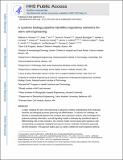A systems biology pipeline identifies regulatory networks for stem cell engineering
Author(s)
Kinney, Melissa A.; Vo, Linda T.; Frame, Jenna M.; Barragan, Jessica; Conway, Ashlee J.; Li, Shuai; Wong, Kwok-Kin; Collins, James J.; Cahan, Patrick; North, Trista E.; Lauffenburger, Douglas A; Daley, George Q.; ... Show more Show less
DownloadAccepted version (1.955Mb)
Publisher Policy
Publisher Policy
Article is made available in accordance with the publisher's policy and may be subject to US copyright law. Please refer to the publisher's site for terms of use.
Terms of use
Metadata
Show full item recordAbstract
A major challenge for stem cell engineering is achieving a holistic understanding of the molecular networks and biological processes governing cell differentiation. To address this challenge, we describe a computational approach that combines gene expression analysis, previous knowledge from proteomic pathway informatics and cell signaling models to delineate key transitional states of differentiating cells at high resolution. Our network models connect sparse gene signatures with corresponding, yet disparate, biological processes to uncover molecular mechanisms governing cell fate transitions. This approach builds on our earlier CellNet and recent trajectory-defining algorithms, as illustrated by our analysis of hematopoietic specification along the erythroid lineage, which reveals a role for the EGF receptor family member, ErbB4, as an important mediator of blood development. We experimentally validate this prediction and perturb the pathway to improve erythroid maturation from human pluripotent stem cells. These results exploit an integrative systems perspective to identify new regulatory processes and nodes useful in cell engineering.
Date issued
2019-07Department
Massachusetts Institute of Technology. Department of Biological Engineering; Massachusetts Institute of Technology. Institute for Medical Engineering & Science; Broad Institute of MIT and Harvard; Harvard University--MIT Division of Health Sciences and TechnologyJournal
Nature Biotechnology
Publisher
Springer Science and Business Media LLC
Citation
Kinney, Melissa A. et al. "A systems biology pipeline identifies regulatory networks for stem cell engineering." Nature Biotechnology 37, 7 (July 2019): 810–818 © 2019 Springer Nature
Version: Author's final manuscript
ISSN
1087-0156
1546-1696